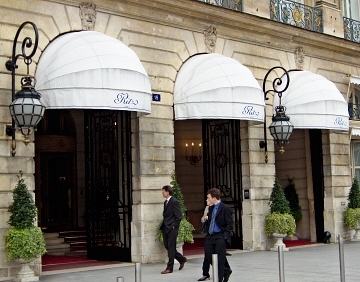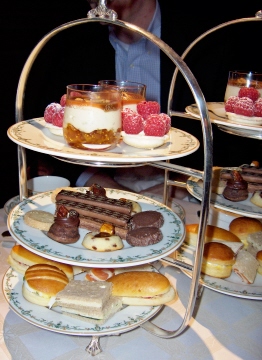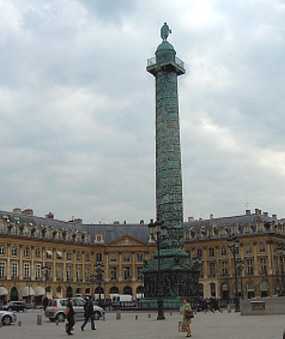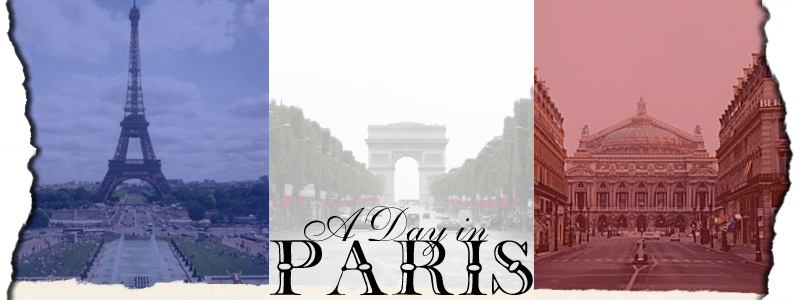Wednesday, May 25, 2005
Tea at the Ritz

Don't ask me why, but I've always wanted to go to the Ritz. Of course, it's a public place and anyone can walk into the hotel, but I just couldn't do it. Once I entered, wouldn't they know I just don't belong there??
So it was with great anticipation that I accepted an invitation from a friend to have high tea at the Ritz. I walked right in and no one asked me what I was doing there. I met my friends at the Bar Vendome in the hotel, the first door on the left and we all ordered tea.
There was a nice selection of teas. The tea trays were very pretty and some of the desserts actually had little chocolate signs with Ritz or "R" on them. Very cute. There were three trays... one savory and two sweet. Although I normally like the sweet stuff, I hadn't had lunch and would have liked more of the delicious sandwiches, especially the smoked salmon roll.
My friends made the tea reservations weeks in advance, but I'm not sure how far ahead of time is necessary. The full tea was 35 euro and we had two pots of fresh tea and lots of food to choose from: sandwiches, scones, rice pudding... The service was a little disappointing. We actually had to spend some of our time just trying to get waiters attention. Overall, a really fun thing to do with some friends and if you have tea late enough, you don't have to worry about dinner!
I took this picture as I was leaving the Ritz. It is the Place Vendome column and was erected by Napoleon I from melted-down enemy canons captured during the battle at Austerlitz. At the top is a statue of Napoleon dressed as a Roman emperor.
-- said Auntie M in Paris
9:27 PM
# posted by mrsmogul : 12:38 AM
# posted by Anonymous : 2:11 AM
# posted by Becca : 3:07 AM
# posted by kenju : 4:26 AM
# posted by Last Girl On Earth : 7:50 AM
Frania W.
# posted by Frania W. : 8:38 AM
Moreover, at 1, place Vendome, one can find the Hotel de Vendome, built in 1723.
From 1842 to 1843 it was the Embassy of the Republic of Texas.
L'Amerloque
# posted by L'Amerloque : 1:01 PM
I've been combing the internet for information on French foods that herald the arrival of a religious holiday, but just foods that might be served in a cafe, like the hot cross buns that appear in teashops in England before Easter, pumpkin pie in coffee shops before Thanksgiving or peppermint lattes before Christmas in America.
Most French holiday food seems to be family food served at the holiday dinner at Mother's place in the country.
There are the chocolate fish that appear in confectioners' shops for April first, to give to your favorite April Fish, but they're unlikely to be listed on the chalk board at your corner cafe and April Fool's Day isn't exactly a church holiday.
I read that blood sausage is served for Reveillon, the dinner/breakfast feast after midnight mass on Christmas Eve, in cafes and restaurants that stay open all night specially for that purpose.
Is blood sausage available all year long? Is it just served for Reveillon?
Might blood sausage be served only in the weeks before Christmas, leading the savvy but somewhat absent minded cafe patron to say, "Zut! Blood sausage! I really must start my Christmas shopping"?
I don't know.
Something I do know or at least that I heard: The day after, French papers report how many kilometers of blood sausage were consumed at Reveillon.
The best idea so far was the Beaujolais Nouveau for La Saint Martin on November 11th. I imagined that when the wine was ready it was served in the cafes and you might guess that St. Martin's Day was near (where's my roast goose?).
But, no. I Googled for Beaujolais Nouveau and found out that, since WWI, Armistice Day has usurped La Saint Martin and that, since 1951, Beaujolais Nouveau has had its own day, the third Thursday in November. Oh, help!
My Marling Menu-Master is good but not for this.
Any suggestions?
Anyway, that's how I found your amazing site. Thank you, thank you for sharing Paris. I'll be back for more.
Cheerful regards, C.G. Blick
p.s. I don't see you sharing email addresses, but, just in case, please don't share mine. Thanks.
# posted by : 7:20 PM
Is blood sausage available all year long?
Yes, but it's better in the autumn. It is possible to find it throughout the year.
Is it just served for Reveillon?
Oh, no. Note that there are two "reveillons": Noel and Saint-Sylvestre. Generally the former is en famille, after attendance at Midnight Mass (if one is a practicing Catholic and/or wants the traditional "French experience", of course). The latter is – usually - with friends. Parties, dancing and so forth.
Might blood sausage be served only in the weeks before Christmas, leading the savvy but somewhat absent minded cafe patron to say, "Zut! Blood sausage! I really must start my Christmas shopping"?
Not really, at least in my experience.(smile)
Note that there are at least two kinds of common blood sausage, boudin (red) and boudin blanc (white). With all the variations (mushrooms, truffles and so on) there are quite a few to choose from. A good place to try prizewinning boudin is at Le Roi du Boudin in Mortagne-au-Perche, in the Orne. The shop is right on the market square; you can't miss it. Last time I tried it was about 18 months ago.
Something I do know or at least that I heard: The day after, French papers report how many kilometers of blood sausage were consumed at Reveillon.
Well, either beforehand or afterwards, yes. Sometimes they predict ("so many bottles of x will be drunk"), but generally the press gives stats for les fetes de fin d'annee, i.e., Christmas and New Year's. So many oysters opened and eaten, so many tons of foie gras downed and so on.
Note that one of the marching songs of the French Foreign Legion is Tiens, voilà du boudin.
The best idea so far was the Beaujolais Nouveau for La Saint Martin on November 11th. I imagined that when the wine was ready it was served in the cafes and you might guess that St. Martin's Day was near (where's my roast goose?). But, no. I Googled for Beaujolais Nouveau and found out that, since WWI, Armistice Day has usurped La Saint Martin and that, since 1951, Beaujolais Nouveau has had its own day, the third Thursday in November. Oh, help!
Beaujolais has nothing whatsoever to do with Saint-Martin. In 1954, to sell what was considered up to then an undrinkable wine when new, a fellow (I think his name was Louis Orizet) invented the novel concept of this marvellous wine that should be drunk when new. Marketing at the time was a nascent discipline and the cash machine took a few years to reach cruising speed. Nowadays millions of bottles are drunk all around the world by people who think they are plugging in to a centuries-old French tradition. Alas, no: last year Beaujolais Nouveau celebrated its fiftieth anniversary. It's one of the greater post-WW2 French commercial successes.
Every year, BN comes out on the third Thursday of the month of November. That's easy for American expats to remember, since Thanksgiving is the fourth Thursday in November. (smile)
Re: Saint Martin: note that we (in the USA, anyway) have a tradition of "Indian Summer", when unseasonably sunny, warm weather breaks into a cold autumn. In France, the same tradition is called "l'ete de la Saint-Martin". Several proverbs are associated with this: L'ete de la Saint-Martin dure trois jours et un brin, i.e., "Saint Martin's Summer lasts three days and bit" and Si le brouillard entoure Saint-Martin, l'hiver passe tout benin, i.e., "If there is fog just before and immediately after Saint-Martin, the winter will be mild".
The ete indien one hears about in France comes from the USA and, as far as I can determine, was popularized by the Franco/American singer Joe Dassin in his song which came out in October, 1975.
Of course, purists (like me (grin)) will immediately point out that all these weather proverbs associated with Saints' days have been pushed forward since the changeover (in France, at least) from the Julian calendar to the Gregorian calendar in 1582. The calendar skipped from October 4, 1582 to October 15, 1582, so the gap is ten days. For England and its colonies, the change did not take place until September 1752. Some churches in some countries never changed, of course: check the Russian Orthodox Calendar. In Russia people celebrate Christmas on January 6th while the Catholics are celebrating Epiphany.
Traditionally, eating roast goose in the British isles was reserved for Michaelmas, the feast of Saint Michael on September 29. Michaelmas was (and still is) one of the traditional English Quarter Days, when accounts had to be submitted and rents had to be paid. Since it was a time to hand over crops to the landlord(s), farmers would fatten up a goose especially for the occasion. There was also a tradition of baking special large loaves of bread for Michaelmas.
If one goes "up" to Oxford or Cambridge, one will find that the autumn term is called the "Michaelmas term", remember.
During the Victorian era, goose was the preferred dish for Christmas among the middle and working classes. There were even "goose clubs", wherein a working man could put away a penny or several ha'pennies each week (a layaway plan) during the entire year and pick up his very own goose on Christmas Eve. A Sherlock Holmes story ("The Adventure of the Blue Carbuncle") is based on this.
During the twentieth century turkey gradually replaced goose on the holiday table in the British Isles.
L'Amerloque
# posted by L'Amerloque : 9:41 PM















